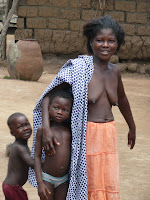 While Cote d'Ivoire is reputed to be the world's largest exporter of cocoa beans, Ghanaians are quick to remind you that they too have held that title, but that their cocoa beans are of much higher quality.
While Cote d'Ivoire is reputed to be the world's largest exporter of cocoa beans, Ghanaians are quick to remind you that they too have held that title, but that their cocoa beans are of much higher quality.Doug remembers going to the Cadbury's plant in Wallasey as a schoolboy on an educational tour and watching an old film that showed a derelict freighter being loaded in Ghana with large sacks of cocoa beans from dugout canoes hitched alongside. The cocoa was bound for processing in England. When the wind blew in the right direction the fragrant smell of chocolate from the Cadbury factory would waft into the house.
So here we were in Ghana - the port of Takoradi a much more modern facility that what that old movie had depicted. Today we were off on an adventure to the Kakum National Park and the Canopy Walkway, several hours drive from Takoradi which has the unusual honour of being the world's largest city closest to the Equator and the Prime Meridian - making it the most centrally located city in the world.
Takoradi and its deep water seaport is twinned with Sekondi, which combined, make the conurbation Ghana's fourth largest city and a vibrant industrial and commercial centre.
The drive revealed life. Homes were constructed in a ramshackle fashion with daily trading taking place at the roadside. We saw many interesting vendors - "Talent Mechanics" being one - and surely very popular given all the broken down vehicles we encountered during the day. "Wise Choice Financial Services" was another one that caught our eye - particularly since its signage announced that "it was opening soon". And who could not shop at the "God is Good Grocery Store"!
Nowhere in Africa has the impact of communications technology struck us quite so strongly. Vodaphone, MTN and Tico being the most common. Cellphone companies and Internet providers use the same tactic to promote their product. A homeowner or landlord is contacted and offered a contract which results in the home being painted in the enterprise's corporate colours.
 First of all we thought all these colourful buildings were commercial outlets, but soon realized there were far too many of them for that to be the case. Vodaphone red was the most prevalent, standing out amongst the dreary collection of shacks and corrugated tin roofs.
First of all we thought all these colourful buildings were commercial outlets, but soon realized there were far too many of them for that to be the case. Vodaphone red was the most prevalent, standing out amongst the dreary collection of shacks and corrugated tin roofs.Arriving at the Kakum National Park we were outnumbered by schoolchildren, there to walk the canopy. A fairly steep climb up uneven stone paved steps carved its way through the forest.
 Butterflies flew around us and there was a cacophony of sound from the undergrowth. The sky was hidden but large rain droplets started to fall, stopping as soon as they had begun. Before long the sun had returned and the temperature soared.
Butterflies flew around us and there was a cacophony of sound from the undergrowth. The sky was hidden but large rain droplets started to fall, stopping as soon as they had begun. Before long the sun had returned and the temperature soared.Arriving at the canopy platform we saw the first of seven rope suspension bridges spanning the trees.
The walkway was nothing more than a series of planks attached to steel ladders suspended by rope netting.
 It was higher than I had expected and looking down was something one did sparingly - we took the advice to look ahead to the end of the ropeway!
It was higher than I had expected and looking down was something one did sparingly - we took the advice to look ahead to the end of the ropeway!

At the fifth landing we met a Ghanaian who told us the walkway had been built with the assistance of Canadians and that in his words "Canadians are very fine people".
There were still two more stretches of swinging walkways to maneuver and we were glad when we eventually stepped foot on terra firma.
This was no Capilano Suspension Bridge, but our day in the Kakum will provide great material when we do our next North Shore tour.

























 We arrived at our Victoria and Alfred waterfront hotel to a warm welcome. Even though it was now 9:30 a.m. our room was ready. The view from our room over the harbour and Table Mountain was picture perfect.
We arrived at our Victoria and Alfred waterfront hotel to a warm welcome. Even though it was now 9:30 a.m. our room was ready. The view from our room over the harbour and Table Mountain was picture perfect. 


 And "oh the thrill" as yet another adventure begins!
And "oh the thrill" as yet another adventure begins!
